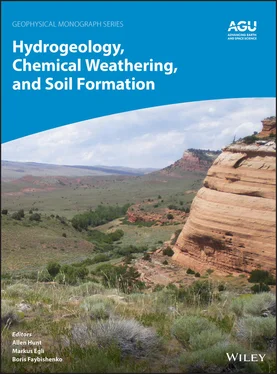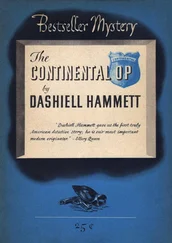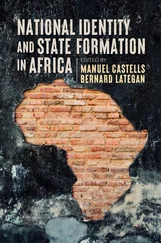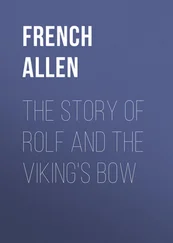Looked at from a deep‐Earth perspective, the formation of soil feeds back into the deep rock hydrologic cycles, potentially providing a limitation on the rate at which sediment can be transported from its source regions on the continents and islands to regions of deposition along rivers, in lakebeds, and especially in oceans. Variable ranges of soil formation in time and space relate to landforms and their changes, as well as to the isostatic adjustments in the Earth’s crust from erosion and deposition. The volume of sediment subducted in trenches is closely related to its water content through its porosity, described through porosity‐depth relationships, linking the subaerial and subsurface water cycles.
Why should we wish to bring out this volume on soil formation and chemical weathering now? Standard interpretations of soil formation and chemical weathering have been challenged in the 21st century. White and Brantley’s (2003) summary of the chemical weathering of silicate minerals has shown that results of laboratory experiments often bear little resemblance to field results, where silicate substrates may be weathering at a rate as much as six orders of magnitude more slowly. These authors showed that the decline in chemical weathering rates conformed to a power law for periods from weeks to about 6 Myr. The decline in weathering rates tracks rather closely the decline in soil formation rates, which have been known for a long time to slow with time, though no consensus had been reached regarding an associated time‐dependence. Field studies (e.g. Blättler & Higgins, 2017; Maher, 2010; White & Brantley, 2003) provide evidence of the relevance of water fluxes to chemical weathering rates and require development of a compatible theoretical framework. Ultimately, interpretations of the development of paleosols together with the evolution of the atmosphere need to be revised accordingly, with possible relevance to such far‐flung topics as extinctions. Partitioning of carbon between ocean, atmosphere, and biosphere has varied drastically over glacial‐interglacial cycles. The resulting swings in atmospheric CO 2and climate are particularly instructive for learning how the weathering feedback works (Frings, 2019).
This volume attempts to place the problem of chemical weathering and soil formation in its geological, climatological, biological, and hydrological perspective. The way in which this is approached is reflected in the organization of the book, which, following Huggett’s defining chapter, continues with a perspective based on Earth’s history (Driese and coauthors). The authors trace the evolution of soils over 3.25 billion years together with geology, paleoclimate and atmospheric composition, and the evolution of life. The following section emphasizes that several basic processes compete for importance in soil formation, namely soil production with its relationship to chemical (and physical) weathering, bioturbation, and aeolian deposition. Chemical weathering and soil formation are related to water and energy fluxes (Hunt), where theoretical approaches of the interactions between the hydrological cycle, soil formation, and net primary production are provided. Le Bayon and coauthors address some of the fundamental aspects of soil formation and development associated with bioturbation, which harks back to Charles Darwin’s initial hypothesis. Clay minerals are important agents in providing nutrients and water to plants. Egli and Mirabella discuss the evolution of clay minerals in alpine soils also in the light of kinetic limitation and percolation. Lukens and Norton depict the role of aeolian deposition in soil formation, as not only water and carbon are transported through the atmosphere, but dust as well. Related to this topic is the chapter of Finke and coauthors in the next section, where loess records are shown to be important climate indicators.
Weathering rinds are indicative of the exposure age of a rock (Sak). In fact, rinds can be considered as microsoils and obey the same weathering principles that also depend on climate. Soil trajectories related to compression from agriculture are discussed in the chapter of Horn and Lal. The role of pedogenesis in geomorphology is discussed in the example of landsliding (Temme). Finally, a cross‐section of integrative field studies is presented with results from several critical zone observatories (CZOs). These include the contribution of Lyons and coauthors on soil formation in the Antarctic dry valleys, Rasmussen and coauthors on the impacts of land‐use change on soils in the southeastern piedmont of the USA, and Suzanne Anderson and coauthors’ discussion of Gordon Gulch from the Boulder Creek CZO. The book closes with a summary of the current state of affairs.
Allen Hunt
Wright State University, USA
Markus Egli
University of Zürich, Switzerland
Boris Faybishenko
Lawrence Berkeley National Laboratory, USA
1 Berner, R. A. (1992). Weathering, plants, and the long‐term carbon‐cycle. Geochimica et Cosmochimica Acta, 56, 3225–3231.
2 Blättler, C. L., & Higgins, J. A. (2017). Testing Urey’s carbonate–silicate cycle using the calcium isotopic composition of sedimentary carbonates. Earth and Planetary Science Letters, 479, 241–251. https://doi.org/10.1016/j.epsl.2017.09.033
3 Darwin, C. (1881). The formation of vegetable mould through the action of worms, with observations on their habits. London: John Murray. (Source: http://darwin‐online.org.uk/converted/pdf/1881_Worms_F1357.pdf)
4 Dokuchaev, V. V. (1883/1948/1967). Russian Chernozem. In Selected works of V. V. Dokuchaev, Moscow, 1948 (vol. 1, pp. 14–419). Jerusalem: Israel Program for Scientific Translations Ltd. (for USDA‐NSF), Publ. by S. Monson, 1967. (Transl. into English by N. Kaner).
5 Frings, P. J. (2019). Palaeoweathering: How do weathering rates vary with climate? Elements, 15, 259–265. DOI: 10.2138/gselements.15.4.259
6 Frings, P. J., & Buss, H. L. (2019). The central role of weathering in the geosciences. Elements, 15, 229–234. DOI: 10.2138/gselements.15.4.229
7 Maher, K. (2010). The dependence of chemical weathering rates on fluid residence time. Earth Planetary Science Letters, 294, 101–110. DOI: 10.1016/j.epsl.2010.03.010
8 White, A. F., & Brantley, S. L. (2003). The effect of time on the weathering rates of silicate minerals. Why do weathering rates differ in the lab and in the field? Chemical Geology, 202, 479–506. https://doi.org/10.1016/j.chemgeo.2003.03.001
Part I Soil Definition
1 Soil as a System: A History
Richard J. Huggett
School of Environment, Education, and Development, University of Manchester, Manchester, UK
The idea of soil as a system is not yet a hundred years old. Its origins lie in Dokuchaev’s view of soil as an independent object, an idea promoted so successfully and eloquently by Hans Jenny. It was Jenny who first thought of soil as a system. His CLORPT equation focused on state factors (external drivers) of the soil system and, later, ecosystems. His approach was largely statistical and empirical. Later, a few researchers investigated energy as a soil‐system driver. A different line of investigation, spurred by Milne’s catena concept, saw soil as a spatial system. Research in this field began in earnest with Simonson’s concept of soil as an open system, which at first involved one‐dimensional soil profiles but was later extended to catenas and three‐dimensional soil landscapes, all researched using a rich variety of statistical and deterministic models. Last came the recognition that soil is part of an interdependent system. This line of enquiry began with conceptual models of the ecosphere. Since the millennium it has made big advances from cross‐disciplinary enquiries focusing on the Earth’s critical zone and interactions between soils and geomorphology, soils and hydrology, soils and life, and soils and humans.
Читать дальше












